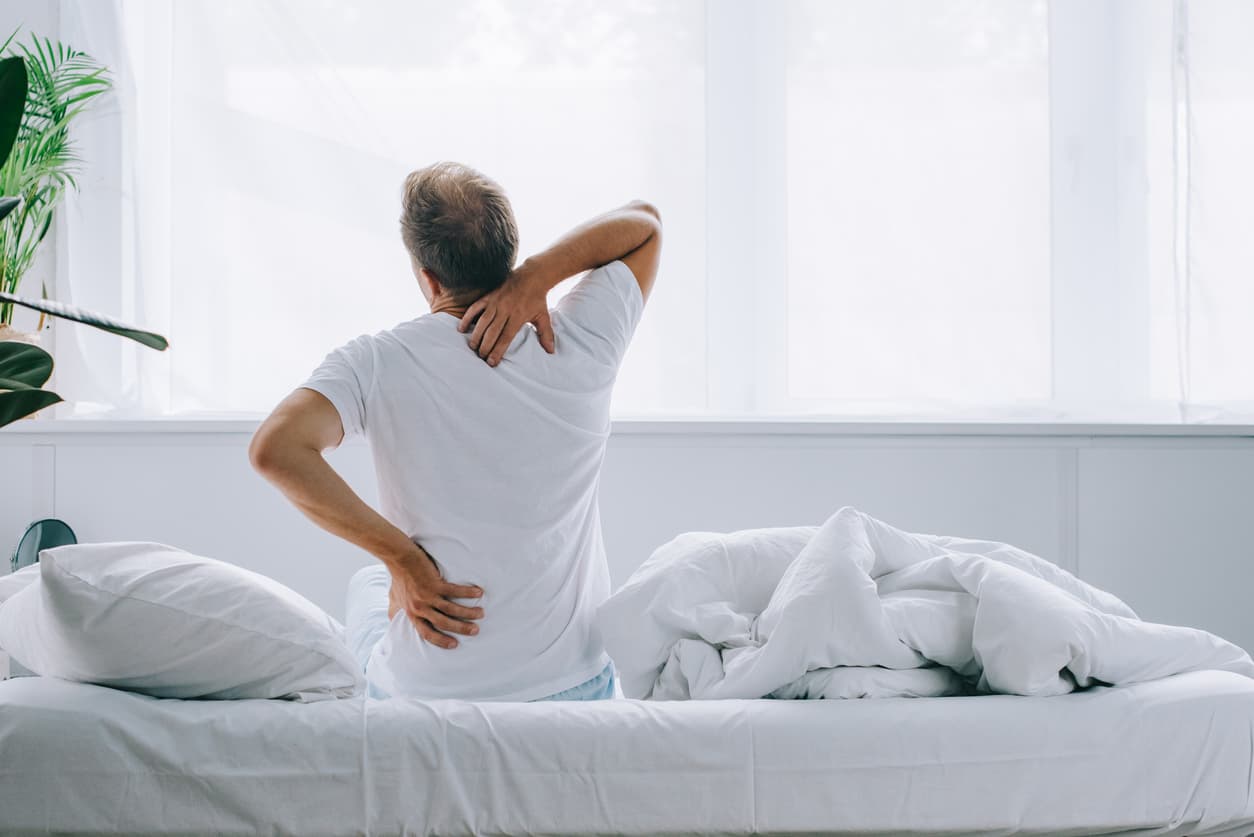How old is your mattress? It might seem like you just got it a couple of years ago, but did you? Time flies—and the mattress that was once a comfy haven of restful sleep might now be impeding your ability to get a good night's sleep.
If you think this might be the case, take a second to ask yourself:
Are you waking up feeling groggy, sore, or stiff?
Are you experiencing more allergy symptoms than normal?
Does your mattress look a little saggy and worn out?
If the answer to any of these questions is “yes”—it might be time to replace your mattress.
How Long Does a Mattress Last?
Unfortunately, even the best quality mattresses don't last forever, but their average lifespan varies depending on the type of mattress.
Innerspring mattresses: Traditional innerspring models are made of metal coils surrounded by batting, and some also have an extra layer of padding called a pillow top. These mattresses tend to last around 5-7 years.
Memory foam: These polyurethane foam mattresses consist of three primary layers: a foundation or base layer, a middle layer of supportive memory foam, and a cushiony top layer that provides comfort and airflow. Depending on the foam quality, you can expect to get about 7-10 years of use out of a memory foam mattress.
Hybrid mattresses: A hybrid mattress combines the best of both traditional innerspring mattresses and memory foam mattresses, providing a great night of sleep for those looking for comfort and pressure relief. Most mattresses in this category have an average lifespan of 7-10 years.
Factors that Influence Your Mattress' Lifespan
There are a lot of different factors that can affect a mattress’ longevity, including:
Mattress materials: Like most products, the higher the quality, the longer your mattress will last. So make sure you buy from a reputable manufacturer like Leesa that prioritizes quality when choosing fabric, foam, and other materials.
Care and maintenance: Regular cleaning and care (according to the manufacturer’s recommendations) can extend your mattress’ life. Likewise, a waterproof mattress protector can help protect your investment from rips, spills, and other damage. Using a mattress pad can also protect against various contaminants and improve your overall sleep experience.
Kids and pets: Mattresses last the longest when a single person is occupying them under normal conditions. If you have kids or pets that share your bed, damage from accidents, stains, jumping, and chewing (hopefully not from your human kids!) can wear out your mattress faster.
Size and body weight: The more weight applied to mattress springs and foams, the faster they break down. Ensuring proper support can help mitigate this effect, but heavier-weight sleepers may still find that their mattresses start to sag or get the “hammock effect” faster than expected.
How Can I Tell When to Replace a Mattress?
Not sure if it's time yet for a new mattress? Here are the top signs you need to replace your mattress, so you can start getting better quality sleep.
Chronic sleep problems
The quality of your sleep has such a significant effect on your overall health, and if you frequently wake up feeling tired, groggy, or just unrefreshed, your old mattress could be to blame. Even if your mattress isn't noticeably saggy, the materials may still be too worn out to provide adequate support, which leads to tossing and turning instead of a restful night's sleep.
Additionally, if your mattress no longer aligns with your sleep preferences, such as firmness level or sleeping position, it could be contributing to your sleep issues.
Allergy and asthma symptoms
If you wake up stuffy and sniffly or start to experience more frequent asthma symptoms, it could be due to mold, bacteria, dust mites , dead skin cells, and other allergens that have built up over the years and are now lurking in your bed. Yuck—we know!
Fortunately, a good mattress protector can help shield your mattress from these pesky allergens, so make sure you invest in one when you replace your mattress.
Aches and pains
Back, neck, shoulder, or hip pain and stiffness, especially upon waking, is often a sure sign that your old mattress is no longer giving you proper spinal alignment or support. When you replace your mattress, you might just be surprised by how many of those "age-related" aches and pains were actually due to a worn-out bed.
Signs of wear
Obvious signs of wear, like noticeable sagging, body impressions, rips, tears, and springs poking out of the top or sides, are clear signs that your mattress needs to be replaced right away. Squeaky, noisy springs are also an early indicator that the coils are starting to degrade and it's about time to add mattress shopping to your to-do list.
How Can I Make My New Mattress Last Longer?
There are a few simple ways you can get the most out of your new mattress. We recommend starting with a good quality mattress and pairing it with the appropriate base or foundation, then extending the life of your investment with proper care and maintenance.
Start with a high-quality mattress
The quality of your mattress materials will have the biggest impact on your new bed's lifespan. So when it's time to replace your mattress, look for a balance of quality and affordability, prioritizing features like:
Natural and sustainably sourced materials
Thoughtful features like reinforced edges and stitching
Leesa has a wide selection of top-quality mattresses to fit every budget, from the cost-effective Leesa Studio Mattress to the ultra-luxurious Reserve Hybrid.
Get the right base or foundation for proper support
The right support underneath is key to maintaining your new bed and ensuring good quality sleep. Each type of mattress requires a different type of support.
Innerspring mattresses typically require a box spring , which contains coils that help distribute the weight of the mattress evenly for less wear and tear.
Foam and hybrid mattresses, on the other hand, sit right on top of a solid or slatted foundation—no box spring required.
If you’re not sure which foundation or base is right for your new mattress, check out our complete guide to bed bases.
Use a mattress protector
Keeping your mattress clean and fresh is important for its longevity. But of course, you can't just toss it in the washing machine, so that's where a washable mattress protector comes in handy.
Not to be confused with a mattress pad or mattress topper, a protector goes on your bed like a fitted sheet, preventing sweat, body oils, dead skin cells, dust, and dust mites from embedding themselves in your mattress. It's a must if you share your bed with kids or pets, as it protects your mattress from all of life's little spills and accidents.
Invest In Your Rest With a New Mattress From Leesa
You deserve quality sleep, and if your bed is no longer delivering, it's time to replace your mattress with one that helps you feel rested and ready to take on your day. But don't forget to follow proper care and maintenance recommendations to ensure your investment in better sleep pays off for years to come.
Not sure where to start? At Leesa, all of our mattresses are thoughtfully designed and built with high-quality, sustainable materials for an ideal balance of comfort and longevity. Whether you need advanced cooling features, reinforced support, or cloud-like softness, we've got you covered.
Take our mattress quiz today to find your perfect match!
FAQs
Still have questions about when to replace your mattress? We have the answers here!
How do I know if my mattress is worn out?
If you’re experiencing back pain, reduced sleep quality, or increased asthma and allergy symptoms, an older mattress is likely to blame. Damaged and worn-out mattresses allow contaminants to seep in and disrupt your sleep quality, and broken-down materials compound the problem until the mattress is unusable.
Can a mattress last 20 years?
A mattress likely will not last 20 years, even if it's maintained perfectly. Mattresses wear and age over time due to frequent, repeated use. Of course, there are many factors that can increase or decrease its longevity, but for the most part, no mattresses last that long. If you're looking for a long-lasting mattress to invest in, consider options like memory foam or latex mattresses that can last up to 10-15 years.
How often should you replace a mattress?
Best practice suggests that all mattresses should be replaced somewhere between every 7-10 years. However, there are many factors that can increase or decrease that frequency—such as wear and tear, mattress type and quality, and the consistency of your mattress maintenance routine.
How do you dispose of a mattress?
The process of disposing of a mattress typically depends on where you live and the condition of your old mattress. Consider connecting with your city to ask about specific regulations that could apply in your case. You might also reach out to your local recycling center or garbage center to ask about mattress-specific requirements and options.



